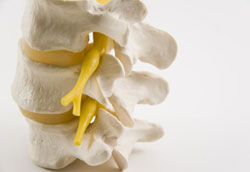Water pressure for a stable spine
The structure of a disc is simple but ingenious and very effective in the fulfilling of its function. It consists of a soft spongy middle surrounded by rings of tough fibrous material, the annuli fibrosi. This enables the two seemingly opposed properties, support and flexibility, to occur together. The project team at the Israel Institute of Technology measured internal water pressure in the annuli fibrosi under applied load. The swelling pressure, from a biochemical point of view, is due to a group of molecules called the proteoglycans. As a result of their structure, they attract and hold water molecules, thus increasing the hydrostatic or osmotic pressure within the disc. The scientists used low-angle X-ray scattering and techniques to measure osmotic stress to give an indirect measure of water content. Subjects studied ranged from 25 to 77 years old. The researchers discovered that the water content depended on age, external osmotic pressure and tissue location. Furthermore, it appeared that disc tension in the annuli fibrosi plays only a minor role in the state of balance of the disc under load. Artificial disc transplantation requires that physical and chemical parameters of the prosthesis are within a certain range. Project results of this nature then can contribute to the effectiveness of disc replacement for sufferers of chronic back pain.

